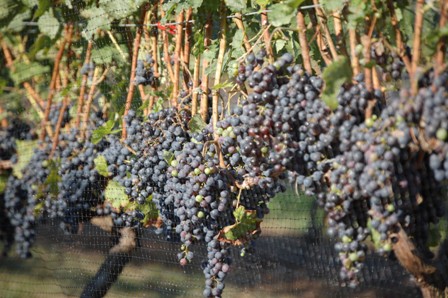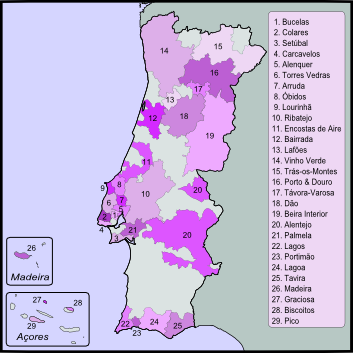|
Portuguese Red Wine. Hidden Gems Everyone Will Love
Portuguese Red Wine Go To: Portuguese red wine is the result of traditions introduced to the region by ancient civilizations, such as the Phoenicians, Carthaginians, Greeks, and mostly the Romans. Portugal started to export its red wines to Rome during the Roman Empire. Modern exports developed with trade to England after the Methuen Treaty in 1703. From this commerce a wide variety of wines started to be grown in Portugal. And, in 1758, the first wine-producing region of the world, the Região Demarcada do Douro was created under the orientation of Marquis of Pombal, in the Douro Valley. Portugal has two wine producing regions protected by UNESCO as World Heritage: the Douro Valley Wine Region (Douro Vinhateiro) and Pico Island Wine Region (Ilha do Pico Vinhateira). Portugal has a large variety of native breeds, producing a very wide variety of different Portuguese red wines with distinctive personality.
History The history of Portuguese red wine has been influenced by Portugal's relative isolationism in the world's wine market, with the one notable exception of its relationship with the British. While wine has been made in Portugal (and neighboring Spain) since at least 2000 BC when the Tartessians planted vines in the Sado and Tagus valleys. By the 10th century BC, the Phoenicians had arrived and introduced new grape varieties and winemaking techniques to the area. Up until this point, viticulture was mostly centered around the southern coastal areas of Portugal. In later centuries, the Ancient Greeks, Celts and Romans would do much to spread viticulture and winemaking further north. Portuguese red wines were first shipped to England in the 12th century from the Entre Douro e Minho region (which today includes modern Portuguese red wine regions such as the Douro and Vinho verde). In 1386, Portugal and England signed the Treaty of Windsor which fostered close diplomatic relations between the two countries and opened the door for extensive trade opportunities. The 1703 Methuen Treaty furthered advanced English economic interest in Portugal by reducing tariffs and give Portuguese wines preferential treatment in the British wine market over French wines. Around this time, the fortified wine known as Port was increasing in popularity in Britain. The lucrative trade in Port prompted the Portuguese authorities to establish one of the world's first protected designation of origin when Sebastião José de Carvalho e Melo, Marquis of Pombal established boundaries and regulations for the production of authentic Port from the Douro in 1756. For centuries after wards, Portuguese red wines came to be associated with Port (and to some extent Madeira which was a popular drink of British colonies across the globe, such as the American colonies.) In the mid-to-late 20th century, sweet, slightly sparkling rosé brands from Portugal (Mateus and Lancers being the most notable) became immensely popular across the globe-with the British wine market again leading the way. In the mid-1980s, Portugal's introduction to the European Union brought a flood of financing and grants to the stagnant Portuguese red wine industry. These new investments paved the way for upgrades in winemaking technology and facilities. Renewed interest in the abundance of unique Portuguese wine grape varieties shifted focus to more premium wine production with a portfolio of unique dry red and white wines being marketed on a global scale.
Regions Portuguese wine regions are grouped into three levels of classification. At the top are the Denominação de Origem Controlada (or DOCs) which are Quality Wines Produced in Specified Regions (QWpsr) under the European Union wine regulations and thus correspond roughly to the French Appellation d'origine contrôlée (AOC) and Spanish Denominación de Origen (DO) classifications. The second group consist of Indicação de Proveniencia Regulamentada (IPRs), and are also QWpsr. IPRs are used for DOC candidates "in training", and this level roughly corresponds to the French Vin Délimité de Qualité Superieure (VDQS) system. The final group are the Vinho Regional (VRs), which are table wines with a geographical indication under EU regulations. VRs each cover a larger area and are similar to the French Vin de pays at regional/departmental level. The early 2000s has seen many changes in the classification and naming of Portuguese wine regions. Many previous IPRs have been elevated to DOC status, either on their own or to create a new, larger DOC from either IPRs or a mixture or smaller DOCs and IPRs. At the same time, the name of some VRs have been modified to allow them to be differentiated from some newly created DOCs which have taken over names of former VRs. As of 2009, there were 26 DOCs for wine (not counting special designations and subregions), 4 IPRs and 11 VRs.
* Alenquer DOC * Alentejo DOC, with the eight subregions Borba, Evora, Granja-Amareleja, Moura, Portalegre, Redondo, Reguengos, and Vidigueira.* Arruda DOC * Bairrada DOC * Beira Interior DOC, with the three subregions Castelo Rodrigo, Cova da Beira, and Pinhel.* Bucelas DOC * Carcavelos DOC * Colares DOC * Dão DOC, with the seven subregions Alva, Besteiros, Castendo, Serra da Estrela, Silgueiros, Terras de Azurara, and Terras de Senhorim, and the special designation Dão Nobre.* Douro DOC, with the three subregions Baixo Corgo, Cima Corgo, and Douro Superior, and the special designation Moscatel do Douro.* Encostas d'Aire DOC, with the two subregions Alcobaça and Ourém.* Lagoa DOC * Lagos DOC * Madeira DOC * Madeirense DOC * Óbidos DOC * Palmela DOC * Porto DOC * Portimão DOC * Tejo DOC, with the six subregions Almeirim, Cartaxo, Chamusca, Coruche, Santarém, and Tomar. (until 2009 known as Ribatejo DOC)* Setúbal DOC with the special designations Moscatel de Setúbal and Setúbal Roxo.* Tavira DOC * Távora-Varosa DOC * Torres Vedras DOC * Trás-os-Montes DOC, with the three subregions Chaves, Planalto Mirandês, and Valpaços.* Vinho Verde DOC, with the nine subregions Amarante, Ave, Baião, Basto, Cávado, Lima, Monção e Melgaço, Paiva, and Sousa, and the two special designations Vinho Verde Alvarinho and Vinho Verde Alvarinho Espumante.Former DOCs Some former separate DOCs have been absorbed into larger DOCs:
* Borba DOC, a subregion within Alentejo DOC since 2003.* Portalegre DOC, a subregion within Alentejo DOC since 2003.* Redondo DOC, a subregion within Alentejo DOC since 2003.* Reguengos DOC, a subregion within Alentejo DOC since 2003.* Vidigueira DOC, a subregion within Alentejo DOC since 2003.Indicação de Proveniência Regulamentada
* Biscoitos IPR * Graciosa IPR * Lafões IPR * Pico IPR Former IPRs While many former IPRs have been elevated to DOC status under the same name, some have instead been absorbed into larger DOCs:
* Alcobaça IPR, a subregion within Encostas d'Aire DOC since 2005.* Almeirim IPR, a subregion within Ribatejo DOC since 2003.* Arrábida IPR, now a part of Palmela DOC.* Cartaxo IPR, a subregion within Ribatejo DOC since 2003.* Castelo Rodrigo IPR, a subregion within Beira Interior DOC since 2005.* Chamusca IPR, a subregion within Ribatejo DOC since 2003.* Chaves IPR, a subregion within Trás-os-Montes DOC since 2006.* Coruche IPR, a subregion within Ribatejo DOC since 2003.* Cova da Beira IPR, a subregion within Beira Interior DOC since 2005.* Encostas da Nave IPR, now a part of Távora-Varosa DOC.* Evora IPR, a subregion within Alentejo DOC since 2003.* Granja-Amareleja IPR, a subregion within Alentejo DOC since 2003.* Moura IPR, a subregion within Alentejo DOC since 2003.* Pinhel IPR, a subregion within Beira Interior DOC since 2005.* Planalto Mirandês IPR, a subregion within Trás-os-Montes DOC since 2006.* Santarém IPR, a subregion within Ribatejo DOC since 2003.* Tomar IPR, a subregion within Ribatejo DOC since 2003.* Valpaços IPR, a subregion within Trás-os-Montes DOC since 2006.* Varosa IPR, now a part of Távora-Varosa DOC.Vinhos Regionais
* Açores VR * Alentejano VR * Algarve VR * Beiras VR * Duriense VR * Lisboa VR (until 2009 known as Estremadura VR)* Minho VR (previously Rios do Minho VR)* Tejo VR (until 2009 known as Ribatejo VR)* Península de Setúbal VR (until 2009 known as Terras do Sado VR)* Terras Madeirenses VR * Transmontano VR (previously Trás-os-Montes VR)
Wines Portugal possesses a large array of native varietals, producing an abundant variety of different wines. The wide array of Portuguese grape varietals contributes as significantly as the soil and climate to wine differentiation, producing distinctive wines from the Northern regions to Madeira Islands, and from Algarve to the Azores. In Portugal only some grape varietals or castas are authorized or endorsed in the Demarcated regions, such as: Porto/Douro Dão Bairrada Colares Carcavelos Setúbal Alentejo Algarve Madeira Portuguese Red Wine Go To: Thank you Wikipedia for the content on this page.
Return from Portuguese Red Wine to Types of Red Wine
|
Sign up for weekly Red Wine Reviews
CLICK HEREWe will send you the extremely popular Red-Wine-Home tasting terms when you sign-up.






